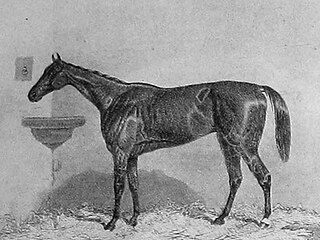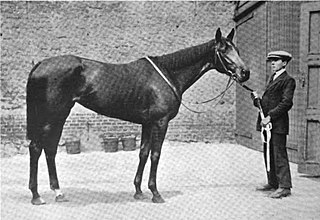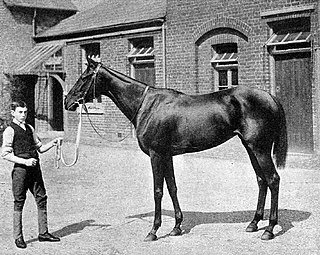
Desert Gold was a famous and successful New Zealand Thoroughbred racehorse who raced at the time of World War I. She raced in Australia and New Zealand, winning 36 races, including 19 in succession.
Tidal Light was a Thoroughbred racehorse who was the champion filly of her year and beat the colts in the 1987 New Zealand Derby.
Katie Lee is a New Zealand Thoroughbred racemare who in November 2009 became the first horse in history to win both the New Zealand 2000 Guineas and the New Zealand 1000 Guineas.

Virago (1851–1869) was a British Thoroughbred racehorse and broodmare. In a career which lasted from November 1853 to July 1855 she ran sixteen times and won eleven races. All but one of her victories came as a three-year-old in 1854, a year in which she dominated British racing, winning major events at distances ranging from one mile to three miles. Her wins included the classic 1000 Guineas at Newmarket, the Nassau Stakes and the Yorkshire Oaks against her own age and sex. More notable were her successes in open competition, including the Goodwood and Doncaster Cups and three of the season's most valuable handicap races. She was regarded by many British experts as one of the greatest racehorses of the 19th century.

Jest (1910–1921) was a British Thoroughbred racehorse and broodmare, best known for winning two Classics in 1913. The filly won four times from eight races in a track career which lasted from July 1912 until July 1913. As a two-year-old in 1912 she won twice from four starts. On her three-year-old debut she won the 1000 Guineas over one mile at Newmarket and then won the Oaks over one and a half miles at Epsom a month later. She was retired from racing after being beaten in the Coronation Stakes at Royal Ascot and the Nassau Stakes at Goodwood. As a broodmare she produced the 1921 Epsom Derby winner Humorist before dying at the age of eleven.

Jannette (1875–1905), was a British Thoroughbred racehorse and broodmare who won two British Classic Races in 1878. She was one of the leading British two-year-olds of 1877 when she was unbeaten in seven races including the Richmond Stakes at Goodwood. On her first appearance as a three-year-old she was beaten by Pilgrimage in the 1000 Guineas at Newmarket but reversed the form with that filly to win the Oaks at Epsom a month later. Later in the season she defeated some of the season's best colts to win the St. Leger Stakes at Doncaster and added a victory in the Champion Stakes against some of the leading older horses. She was less effective in 1879 but won the Jockey Club Cup on her final appearance. She was then retired to stud, where she had some success.
Garden Path was a British Thoroughbred racehorse and broodmare who won the classic 2000 Guineas in 1944. In a racing career conducted entirely at Newmarket Racecourse the filly ran six times and won three races. She was one of the best British two-year-olds of 1943, when she won one race and was placed in both the Middle Park Stakes and the Cheveley Park Stakes. After winning on her first appearance of 1944 she became the first filly since 1902 to win the 2000 Guineas against colts. On her only subsequent race she was injured when finishing unplaced in the Derby. She was retired from racing at the end of the season and had some success as a broodmare.
Charlotte was a British Thoroughbred racehorse and broodmare who won the inaugural running of the classic 1000 Guineas at Newmarket Racecourse in 1814. The Guineas was Charlotte's only race as a three-year-old but she returned to run four times in 1814. She won a Gold Cup at Stamford but was retired after being injured in a race at the same course a day later.

Queen of Trumps (1832–1843) was a British thoroughbred racehorse and broodmare best known for winning the classic Oaks and St Leger Stakes in 1835, becoming the first horse to win both races. In a racing career which lasted from October 1834 until October 1836 she won ten of her eleven races. After being successful in her only race as a two-year-old, she defeated the 1000 Guineas winner Preserve in the Oaks on her three-year-old debut. Later that year she started as favourite for the St Leger and won from a field which included Preserve and The Derby winner Mundig. Queen of Trumps sustained her only defeat a few days later when she was attacked by a dog in the closing stages of the Scarborough Stakes. She was retired to stud after winning all four of her races in 1836. Queen of Trumps died in 1843 at the age of eleven. She was described by a contemporary writer as "certainly the most extraordinary mare these our days have seen".
Lovely Rosa was an Irish-bred, British-trained Thoroughbred racehorse and broodmare best known for her win in the 1936 Epsom Oaks. As a juvenile in 1945 she showed some promise when finishing second in the Queen Mary Stakes and winning a race at Newbury but then showed little worthwhile form until her 33/1 upset victory in the Oaks. She never won again and was retired at the end of 1936. She had some success as a broodmare, most notably being the grand-dam of Wilwyn.

Princess Dorrie was a British Thoroughbred racehorse and broodmare. As a two-year-old in 1913 she failed to win a race but was very consistent, finishing placed in seven of her eight starts. In the following year she was probably the best three-year-old filly in England, winning both the 1000 Guineas and the Epsom Oaks. She was retired at the end of the 1914 season and had modest success as a broodmare.

Our Lassie was a British Thoroughbred racehorse and broodmare. She was a very good performer as a juvenile in 1902 when she won the Sandown Produce Stakes and was placed in her other three starts. In the following year she failed in the Lincoln Handicap but the recorded a decisive win in the Oaks Stakes. She failed to win or place in four subsequent races and was retired from racing at the end of 1904. As a broodmare she produced a few winners but had her biggest impact on the future of Thoroughbred racing through her unraced daughter Lady Brilliant.
Book Law was a British Thoroughbred racehorse and broodmare. The best female racehorse of her generation in Britain, she was noted for her courage and consistency and in her prime she was described as a "fighting machine".

Tranquil was a British Thoroughbred racehorse and broodmare. She showed considerable promise as a two-year-old when she won one race and finished second in the Gimcrack Stakes. In the following season she was one of the best horses in Britain, scoring classic victories in the 1000 Guineas and St Leger Stakes as well as winning four other races including the Jockey Club Cup and Newmarket Oaks. he won once in 1924 before her racing career was ended by injury. She made no impact as a broodmare.
Tide-way was a British Thoroughbred racehorse and broodmare. She was rated one of the best British two-year-old fillies of 1935 when she won twice from four starts. She won the 1000 Guineas on her debut as a three-year-old but finished unplaced in the Epsom Oaks and never ran again. As a broodmare she produced the Eclipse Stakes winner Gulf Stream.
Taj Mah was an Irish-bred, French-trained Thoroughbred racehorse and broodmare. She showed ability as a two-year-old in France when she won three of her five races but was not expected to make further progress. In the spring of 1929 she was sent to England and recorded a 33/1 upset victory in the 1000 Guineas but never raced again. As a broodmare she produced at least two high-class winners.
Cinna was a British Thoroughbred racehorse and broodmare. She showed great promise as a juvenile in 1919 when she won a very competitive maiden race on her debut before finishing second in the New Stakes and the Bretby Stakes. As a three-year-old she won the 1000 Guineas and the Coronation Stakes and was narrowly beaten when favourite for the Epsom Oaks. She was retired from racing at the end of the year and went on to be a very successful broodmare. Three of her sons became leading sires in Australasia whilst several of her daughters became influential broodmares including the female-line ancestors of Sunday Silence and Indian Ridge.
Canyon was a British Thoroughbred racehorse and broodmare. As a two-year-old in 1915 she won three races including the Bedford Stakes and the Bretby Stakes as well as finishing second in the Dewhurst Stakes. In the following spring she recorded her biggest win when defeating Fifinella in the 1000 Guineas. Canyon failed to win again but after her retirement from racing she became a very successful broodmare, whose offspring included Colorado and two other major winners.

Chelandry (1894–1917) was a British Thoroughbred racehorse and broodmare. She was the top-rated juvenile filly in England in 1896 when she won the Woodcote Stakes, Great Surrey Breeders' Foal Plate, National Breeders' Produce Stakes and Imperial Produce Stakes. In the following year she won the 1000 Guineas and finished second in both the Epsom Oaks and the St Leger. She remained in training as a four-year-old but failed to win again and was retired at the end of the year. After her retirement from racing, she became an exceptionally successful and influential broodmare.
Mimi was a dual classic-winning British Thoroughbred racehorse and broodmare. As a two-year-old in 1890 she showed very promising form to win her first four starts but was well beaten when stepped up in class to contest the Middle Park Plate and the Dewhurst Plate. She established herself as the best filly of her generation in May 1891 with three wins in 26 days, taking the 1000 Guineas over one mile, the Newmarket Stakes over ten furlongs and the Oaks Stakes over one and a half miles. She was subsequently beaten in the Prince of Wales Stakes at Leicester and was no match for Common in the St Leger. She was retired from racing at the end of the year and went on to have some success as a dam of winners.








